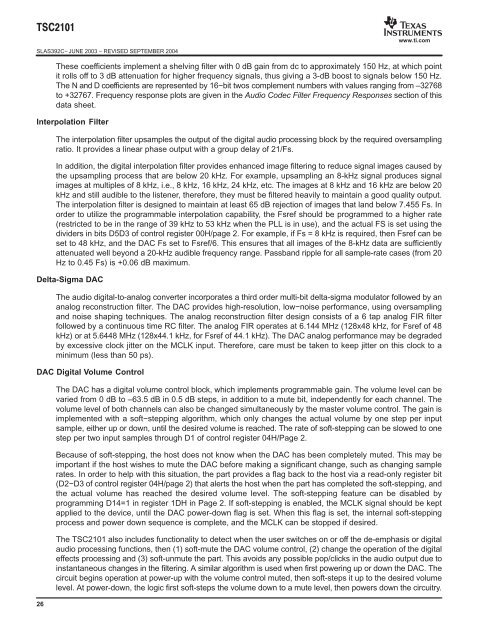TSC2101-Audio Codec w/ Integrated Headphone Speaker Amp ...
TSC2101-Audio Codec w/ Integrated Headphone Speaker Amp ...
TSC2101-Audio Codec w/ Integrated Headphone Speaker Amp ...
You also want an ePaper? Increase the reach of your titles
YUMPU automatically turns print PDFs into web optimized ePapers that Google loves.
SLAS392C− JUNE 2003 − REVISED SEPTEMBER 2004www.ti.com26These coefficients implement a shelving filter with 0 dB gain from dc to approximately 150 Hz, at which pointit rolls off to 3 dB attenuation for higher frequency signals, thus giving a 3-dB boost to signals below 150 Hz.The N and D coefficients are represented by 16−bit twos complement numbers with values ranging from –32768to +32767. Frequency response plots are given in the <strong>Audio</strong> <strong>Codec</strong> Filter Frequency Responses section of thisdata sheet.Interpolation FilterThe interpolation filter upsamples the output of the digital audio processing block by the required oversamplingratio. It provides a linear phase output with a group delay of 21/Fs.In addition, the digital interpolation filter provides enhanced image filtering to reduce signal images caused bythe upsampling process that are below 20 kHz. For example, upsampling an 8-kHz signal produces signalimages at multiples of 8 kHz, i.e., 8 kHz, 16 kHz, 24 kHz, etc. The images at 8 kHz and 16 kHz are below 20kHz and still audible to the listener, therefore, they must be filtered heavily to maintain a good quality output.The interpolation filter is designed to maintain at least 65 dB rejection of images that land below 7.455 Fs. Inorder to utilize the programmable interpolation capability, the Fsref should be programmed to a higher rate(restricted to be in the range of 39 kHz to 53 kHz when the PLL is in use), and the actual FS is set using thedividers in bits D5D3 of control register 00H/page 2. For example, if Fs = 8 kHz is required, then Fsref can beset to 48 kHz, and the DAC Fs set to Fsref/6. This ensures that all images of the 8-kHz data are sufficientlyattenuated well beyond a 20-kHz audible frequency range. Passband ripple for all sample-rate cases (from 20Hz to 0.45 Fs) is +0.06 dB maximum.Delta-Sigma DACThe audio digital-to-analog converter incorporates a third order multi-bit delta-sigma modulator followed by ananalog reconstruction filter. The DAC provides high-resolution, low−noise performance, using oversamplingand noise shaping techniques. The analog reconstruction filter design consists of a 6 tap analog FIR filterfollowed by a continuous time RC filter. The analog FIR operates at 6.144 MHz (128x48 kHz, for Fsref of 48kHz) or at 5.6448 MHz (128x44.1 kHz, for Fsref of 44.1 kHz). The DAC analog performance may be degradedby excessive clock jitter on the MCLK input. Therefore, care must be taken to keep jitter on this clock to aminimum (less than 50 ps).DAC Digital Volume ControlThe DAC has a digital volume control block, which implements programmable gain. The volume level can bevaried from 0 dB to –63.5 dB in 0.5 dB steps, in addition to a mute bit, independently for each channel. Thevolume level of both channels can also be changed simultaneously by the master volume control. The gain isimplemented with a soft−stepping algorithm, which only changes the actual volume by one step per inputsample, either up or down, until the desired volume is reached. The rate of soft-stepping can be slowed to onestep per two input samples through D1 of control register 04H/Page 2.Because of soft-stepping, the host does not know when the DAC has been completely muted. This may beimportant if the host wishes to mute the DAC before making a significant change, such as changing samplerates. In order to help with this situation, the part provides a flag back to the host via a read-only register bit(D2−D3 of control register 04H/page 2) that alerts the host when the part has completed the soft-stepping, andthe actual volume has reached the desired volume level. The soft-stepping feature can be disabled byprogramming D14=1 in register 1DH in Page 2. If soft-stepping is enabled, the MCLK signal should be keptapplied to the device, until the DAC power-down flag is set. When this flag is set, the internal soft-steppingprocess and power down sequence is complete, and the MCLK can be stopped if desired.The <strong>TSC2101</strong> also includes functionality to detect when the user switches on or off the de-emphasis or digitalaudio processing functions, then (1) soft-mute the DAC volume control, (2) change the operation of the digitaleffects processing and (3) soft-unmute the part. This avoids any possible pop/clicks in the audio output due toinstantaneous changes in the filtering. A similar algorithm is used when first powering up or down the DAC. Thecircuit begins operation at power-up with the volume control muted, then soft-steps it up to the desired volumelevel. At power-down, the logic first soft-steps the volume down to a mute level, then powers down the circuitry.







